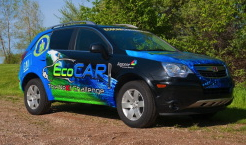
EcoCAR: the NeXt Challenge Results
By Design Engineering staff
General Automotive electric vehicle R&D transporation UniversityCanadian Eng. students place second with EREV powertrain design

The winners of the first leg of a three-year collegiate engineering competition were announced in Toronto, today. Dubbed EcoCAR: the NeXt Challenge, the contest tasks 17 University-student engineering teams from across North America (including three from Canada) with re-engineering a 2009 Saturn Vue with an alternative fuel powertrain that cuts fuel consumption and emissions without sacrificing performance, safety or curb appeal.
Although the University of Victoria looked like the favorite through most of the first leg, students from the Ohio State University took the checkered flag for their design of an Extended Range Electric Vehicle (EREV) powered by a 1.8 litre engine and fueled by E85 ethanol. The team predicts its power train design will result in a 300 per cent increase in fuel economy over the production Saturn Vue’s 4 cylinder vehicle.
University of Victoria team, which also designed an EREV vehicle that runs on E85 ethanol, took second place design, while Mississippi State University was awarded third place for its EREV, B20 biodiesel.
During the past year, participating teams have been working to design the next generation of green vehicle technologies. For this first year of the three-year competition, students were tasked with creating concepts for their vehicle design and given the opportunity to use advanced software and computer modeling tools, which allowed for testing and refinement under the simulation of real-world conditions.
In year two of the competition, teams will incorporate their powertrains into the Saturn VUE. In the final year, teams will refine their vehicles into a final "showroom" quality vehicle.
Students were encouraged to explore a variety of solutions including hybrid, plug-in hybrid, fuel cell, electric, and extended range electric vehicles.
- Extended Range Electric Vehicles (EREV): Almost half of the EcoCAR teams, including Ohio State, University of Wisconsin, and Virginia Tech chose to design Extended Range Electric Vehicles, which, like GM’s Chevy Volt, demonstrate full performance with an electric powertrain for all electric driving and an optimized combustion engine that can extend the range of the vehicle with its on-board fuel storage. The other EREV teams are Embry-Riddle Aeronautical University, Mississippi State University, North Carolina State University, Penn State and University of Victoria.
- Full Function Electric Vehicle (FFEV): One team, University of Ontario Institute of Technology chose to design a Full Function Electric Vehicle, which emits zero emissions consuming no liquid or gaseous fuel.
- Fuel Cell Plug-in Hybrid Electric Vehicle (FC-PHEV): Two of the seventeen EcoCAR teams, University of Waterloo and Missouri University of Science and Technology, have designed a Fuel Cell Plug-in Hybrid Vehicle which uses an onboard hydrogen fuel cell to either propel the vehicle or recharge a battery pack.
- Plug-In Hybrid Electric Vehicles (PHEV): Six of the EcoCAR teams, including Texas Tech, West Virginia University, and Michigan Tech have designed Plug-In Hybrid Electric Vehicles which utilize a large lithium ion battery. The other PHEV teams include Howard University, Georgia Tech, Rose-Hulman Institute of Technology.
